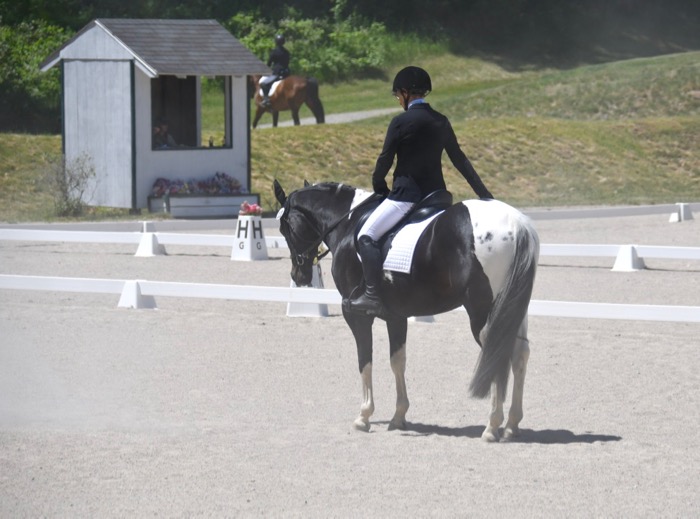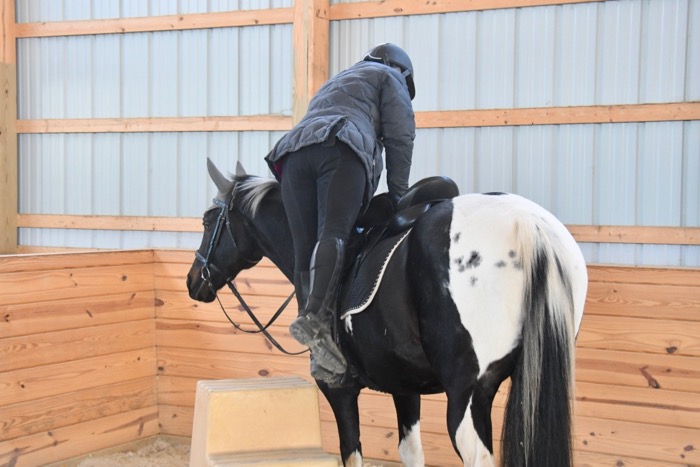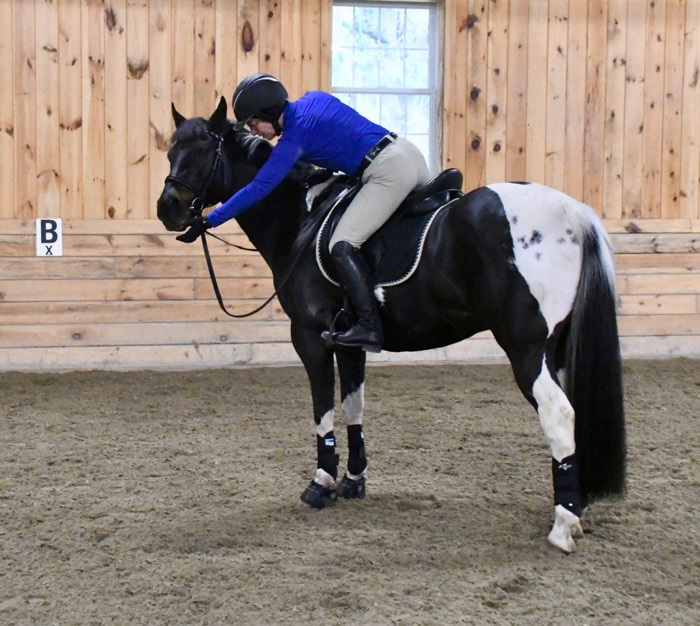When you ride dressage, you care about the details. Where each hoof falls, the height of the poll, the way the shoulder follows the arc of a circle. It’s all too easy to micromanage every stride, to push and constrain so that the horse’s body goes exactly where you want it to. Doing that might get the end result, but I don’t think it’s fun for you or your mount. I want the horse to take the initiative to make it right. To do that, he has to understand the goal and want success as much as you do. For that, it’s up to you to explain what the criteria are, and make reaching them rewarding.
A basic requirement of dressage (or any riding, really) is that your horse halts when you ask them to. It’s best for the horse if all four legs are evenly underneath them, so that the weight of the rider is plumb on their back. This is what a square halt looks like in the dressage ring.

The training for this began well before I even began schooling trot to halt transitions.
Tonka doesn’t always have perfect posture. I sympathize. Neither do I. This is how he likes to relax in the paddock. Hind hoof cocked, hips sloped.

This is comfy for standing in the sun, but not the stance that is good for him when I get on. So, I ask him to square up at the mounting block. Every time! When I get on him and he is this balanced, it feels better for him than if he has a hind leg strung out. It’s innately rewarding.

But, even so, I confirm his good choice with a cookie.

Maybe three or four times during a ride, Tonka will do something that I want to mark and treat. I can’t feed a horse that’s moving, and it’s not good for his body to slam on the brakes to get his cookie, so I’ve taught him that the reward comes after a balanced stop into a square halt. This video is from two years ago. This training never ends! (Note that although I use a clicker to let Tonka know that he’s done something brilliant, I direct what he does with traditional body cues – squeezing with my legs, contact with the reins, etc. I like the fluent conversation that this engenders.)
I always finish the schooling ride with a square halt, and a cookie.

This stance has become so rewarding to him, that I can run up the stirrups, loosen the girth, and walk away, and he’ll remain in it. (Photo taken yesterday.)

Because Tonka understands that when he stops, it’s best to stand squarely, when we do ride down the centerline he does this. Watch carefully. He brings his right hind just a tad forward, all on his own.
Tonka has trotted down the centerline enough to know that the cookie doesn’t happen in the show ring – but he also knows that Steve will be waiting right outside of the gate with a peppermint. To get that reward I don’t ask for a square halt!


Brilliant!!!
Thanks!
I hope you got a 10 for that last halt!
A 7.5. “Almost straight” was the comment. But we did win the class 🙂
Just wondered, did you train for the square halt from his back or on the ground or both. When we used to show Quarter Horses in halter, they had to stand square to be judged, we trained for that on the ground.
I’ve trained it on the ground, but not with as much finesse as is required for the show ring. Karen Pryor once trained show horses to not only stand square, but also tor prick their ears forward!
Training Tonka to stop and stand squarely is an elegant job, I’m very impressed. Gale and I worked on a horse she was riding a while ago, and he just couldn’t square up. One hind leg always came forward on a halt. From what I’ve learned watching Terry to work on Tonka, I now suspect that other horse had some discomfort in his back or hindquarters that made him ease his weight off that foot; but I’m not skilled enough to know.
KP
There probably was discomfort in there. It’s so difficult to tell with horses where the pain originates and if there’s anything to do for it.